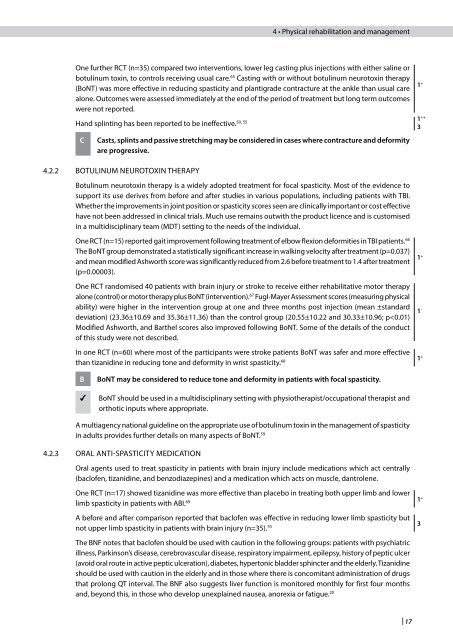sign130
sign130
sign130
Create successful ePaper yourself
Turn your PDF publications into a flip-book with our unique Google optimized e-Paper software.
One further RCT (n=35) compared two interventions, lower leg casting plus injections with either saline or<br />
botulinum toxin, to controls receiving usual care. 65 Casting with or without botulinum neurotoxin therapy<br />
(BoNT) was more effective in reducing spasticity and plantigrade contracture at the ankle than usual care<br />
alone. Outcomes were assessed immediately at the end of the period of treatment but long term outcomes<br />
were not reported.<br />
50, 55<br />
Hand splinting has been reported to be ineffective.<br />
C Casts, splints and passive stretching may be considered in cases where contracture and deformity<br />
are progressive.<br />
4.2.2 BOTULINUM NEUROTOxIN THERAPy<br />
Botulinum neurotoxin therapy is a widely adopted treatment for focal spasticity. Most of the evidence to<br />
support its use derives from before and after studies in various populations, including patients with TBI.<br />
Whether the improvements in joint position or spasticity scores seen are clinically important or cost effective<br />
have not been addressed in clinical trials. Much use remains outwith the product licence and is customised<br />
in a multidisciplinary team (MDT) setting to the needs of the individual.<br />
One RCT (n=15) reported gait improvement following treatment of elbow flexion deformities in TBI patients. 66<br />
The BoNT group demonstrated a statistically significant increase in walking velocity after treatment (p=0.037)<br />
and mean modified Ashworth score was significantly reduced from 2.6 before treatment to 1.4 after treatment<br />
(p=0.00003).<br />
One RCT randomised 40 patients with brain injury or stroke to receive either rehabilitative motor therapy<br />
alone (control) or motor therapy plus BoNT (intervention). 67 Fugl-Mayer Assessment scores (measuring physical<br />
ability) were higher in the intervention group at one and three months post injection (mean ±standard<br />
deviation) (23.36±10.69 and 35.36±11.36) than the control group (20.55±10.22 and 30.33±10.96; p


